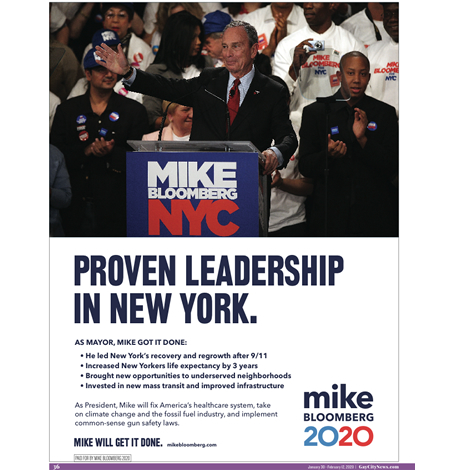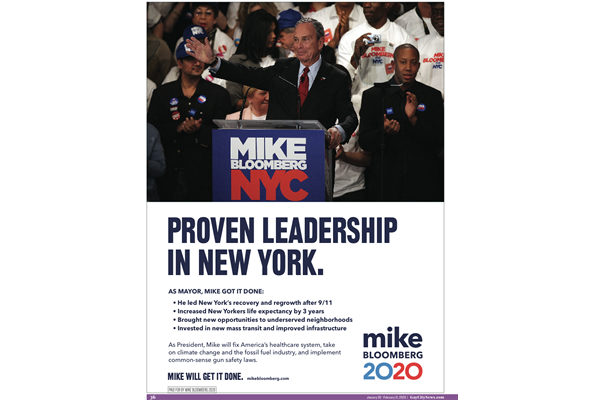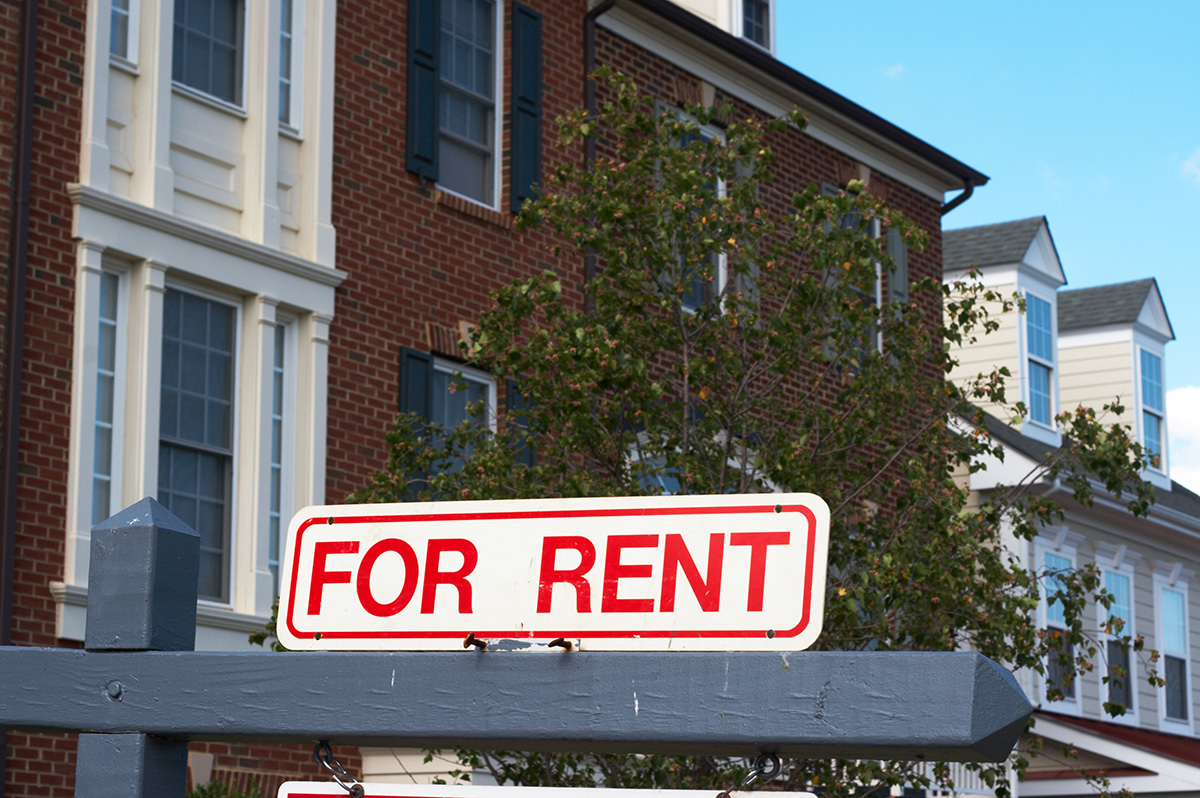Financial
Presidential hopefuls not showing love to LGBTQ media
Few ad buys in niche outlets in 2020 campaign


When it comes to covering the concerns of our community, nobody does it better than LGBTQ print and digital media outlets. Readers hungry for in-depth journalism know the value of hearing it from the horse’s mouth—so why is that lost on the lion’s share of donkeys and elephants?
“I personally have reached out to Buttigieg, Biden, Sanders, Warren, and Bloomberg, with no response from anyone about advertising,” said Justin Wyse, sales manager for South Florida Gay News, in a Feb. 23 email (before Buttigieg, the gay former mayor of South Bend, Ind., suspended his campaign). Democratic presidential hopefuls may be rebuffing Wyse’s overtures, but PACs sometimes have the paper’s back: The Log Cabin Republicans, he notes, planned to advertise in the two issues prior to Florida’s March 17 primary.
Still, not a single candidate has advertised with the paper in past presidential election cycles, says Wyse. “They all say they support our community, but do they? They sure don’t show it, by their silence.”
That silence, if broken, could speak volumes, says Rivendell Media president and CEO Todd Evans. “For a million dollars, you could completely saturate the LGBTQ media market. For $100,000, you will get the back cover in most gay print publications in top U.S. markets,” notes Evans, who places advertisements for the National LGBT Media Association—whose 12 members have a combined weekly print and online reach of approximately 500,000. (The Washington Blade and Los Angeles Blade are members.)
Of that niche market, says activist and Philadelphia Gay News publisher Mark Segal, “One of the things we share with the African-American and Latino community is, LGBTQ print is king. When candidates are trying to get to a community, they go in all manners—mailings, targeted social media. So when you go after our votes,” says Segal, of LGBTQs, “part of that is advertising.”
Over the years, says Evans, “We have compiled campaigns and reach-outs to the DNC. They’ve asked for it, even. But they’ve never done anything on a national scale, to my knowledge, ever… Let’s go back to the reason companies target LGBTQs: Primarily, for trend-setting. Why wouldn’t you want to carry that into getting yourself more visibility within our community?”
In anticipation of Pennsylvania’s April 28 primary, Segal notes that despite early outreach to Democrats with designs on the White House, “What they all say is, ‘Get back to us on April 1.’ ” (Sanders and Clinton did advertise with the paper in 2016; the former, with a mainstream ad, and the latter, with one designed for LGBTQ+ readers.)
Using the National LGBT Media Association as his calling card, this reporter requested comment from the RNC, DNC, and Democratic candidates. Only two campaigns responded.
Touting their track record of “locking arms and marching during Pride” as well as attending the National LGBTQ Task Force’s Creating Change Conference and RuPaul’s Drag Con, “Team Warren knows the importance of meeting LGBTQ+ voters where they are,” said Daniel Lander, Elizabeth Warren’s National Director for LGBTQ+ Outreach, in a Feb. 24 email.
This article’s deadline forced us to call off the search for answers to our reply, in which we asked if the Warren campaign had taken its message directly to the LGBTQ, Hispanic, or African-American press, via paid advertising.
Bloomberg campaign rep Natalie Johnson assured, in a Feb. 20 email, “We have great team members that can speak to this topic.” But after a phone call at her behest, “to get a better sense of the interview,” it was radio silence after we declined to send a list of questions prior to securing an interview.
Past NYC mayor and present billionaire Michael Bloomberg, who dropped out of the race on March 4 after a dismal Super Tuesday showing, did indeed purchased a presence in the LGBTQ press, albeit a general interest ad that appeared as part of a company-wide buy with Schneps Media, whose properties include NYC’s Gay City News (GCN), a member of the National LGBT Media Association.
When we spoke with GCN founding editor-in-chief and associate publisher Paul Schindler, he noted the issue that hit the streets on Jan. 30 had a back page ad from Bloomberg.
“In his mayoral campaigns,” recalls Schindler, of Bloomberg, “he blanketed our newspapers and our digital with ads. He so outspent his Democratic rivals, there was no competition.”
The Stonewall Democratic Club of NYC and Lambda Independent Democrats of Brooklyn “have endorsed Elizabeth Warren,” notes Schindler, “so if Warren remains viable by the time of the [April 28 NY Democratic] primary, I think there’s a decent shot those clubs would buy an ad, but not much more than two or three weeks before the primary.” (Those clubs, if advertising, won’t be bolstering Warren: The Massachusetts senator called it quits on March 5.)
There’s good reason, says Schindler, that candidates are absent from the local landscape until their time in the primary sun is at hand. “Unlike other consumer products, they are not ‘on sale’ everywhere at the same time… I want to make it very clear that I’m stepping aside from my role as editor, when I say I’m glad they’re spending their money where they are [in battleground states and pre-primary buys]. That’s not something smart for me to say, businesswise, but it’s a cold political fact.”
Even colder and considerably more calculated, is the quest to bypass ads altogether, by pricking up LGBTQ+ ears with a compelling sound bite.
“Candidates [in 2020] do seem to be a bit more reluctant to tap into niche markets by paying for media,” says T.J. Billard, a Ph.D. candidate at the USC Annenberg School for Communication & Journalism. “They tend to focus on the mainstream,” or rely on “earned media,” i.e., no-cost editorial coverage, as was the case numerous times, notes Billard, when Warren, “just in the course of talking about violence, mentioned transgender women of color. For a general audience, it doesn’t do much. But the fact that she said it is going to be news in the LGBTQ press. So by throwing that in, she’s able to assure a certain degree of visibility in the LGBTQ community that requires no [financial] investment.”
“I’ve seen the tone shift, now that we’re in a post-marriage equality era,” says public affairs and media professional Kenn Campbell, who served as a national advance associate on behalf of the Obama White House, the Office of Secretary Hillary Rodham Clinton, and Hillary for America. “Campaigns aren’t reaching out as early as they were, and they aren’t targeting the LGBT community as aggressively as I think they should be … I would hope DNC Chair Perez has a [general election] plan for that. But at this point, I haven’t seen any outreach effort.”
Scott Wazlowski, vice president of advertising for San Francisco’s Bay Area Reporter, was in talks with a presidential candidate when we spoke, but under “a fairly comprehensive” non-disclosure agreement. Wazlowski notes the paper’s “strong voting bloc” garners advertising from the city’s Department of Elections “prior to every election in the city and county,” as well as advertising from Congresswoman Nancy Pelosi, prior to annual Pride celebrations.
Even for a paper of BAR’s visibility, notes Wazlowski, “Reaching the right person who makes the decision on who buys media for anything other than a small local campaign is almost impossible.”
Of the LGBTQ press, “We are on the front lines, in terms of our local communities,” says Michael Yamashita, president and CEO of BAR Media Inc., and BAR publisher. “I don’t think campaigns really appreciate that direct and close relationship we have.”
Real Estate
Navigating DMV real estate market during political unrest
Reductions in federal employment have introduced uncertainties

The Washington, D.C.-Maryland-Virginia (DMV) region has long been recognized for its robust housing market, underpinned by the presence of the federal government and a diverse economic landscape. Recent massive reductions in federal employment have introduced uncertainties, yet the area continues to offer compelling reasons for prospective homebuyers, particularly within diverse communities.
While the federal government has traditionally been a significant employer in the DMV, the region has proactively diversified its economic base. Sectors such as technology, professional services, education, and healthcare have expanded, mitigating the impact of federal job cuts. This diversification fosters some economic resilience, which offers our area a semblance of protection against the impending unknowns that we currently face. Nothing can shield real estate entirely; however, our area tends to survive these types of changes better than other parts of the country.
Despite concerns over federal layoffs, the DMV housing market has demonstrated notable stability. Analyses indicate that the number of active listings, sold properties, and median sales prices have remained steady on a year-over-year basis. This steadiness suggests that the market is adapting to changes without significant disruption.
Furthermore, while there has been a slight increase in home listings, this trend aligns with typical seasonal variations and does not solely reflect federal employment changes. The luxury property segment, in particular, continues to thrive, indicating sustained interest and investment in the region.
The DMV region is renowned for its cultural and demographic diversity, with areas like Montgomery County, Md., being among the most ethnically diverse in the nation. This inclusivity extends to various communities, including LGBTQ individuals, fostering a welcoming environment that enhances the area’s appeal. Even though the current administration is fostering anti-diversity ideology, I remain confident that our LGBTQ community will continue to thrive even as these destructive forces work against us.
Local governments within the DMV have implemented policies aimed at promoting affordable housing and preventing displacement, particularly in the wake of economic shifts. Initiatives like the Douglass Community Land Trust in Washington, D.C., exemplify efforts to maintain housing affordability and support community stability.
Additionally, jurisdictions such as Montgomery County have longstanding Moderately Priced Dwelling Unit (MPDU) programs that require developers to include affordable housing in new residential developments. These policies contribute to socioeconomically mixed neighborhoods, benefiting diverse populations.
Despite Elon Musk’s brandishing of a chainsaw to the federal workforce, our real estate market continues to thrive. The DMV region maintains its appeal. Economic diversification, market stability, commitment to diversity and inclusion, and progressive housing policies collectively contribute to an environment that supports and attracts diverse communities. Prospective homebuyers can find reassurance in the region’s resilience and ongoing efforts to foster an inclusive and vibrant community. These are only a few among the many reasons to have a positive outlook while considering real estate options in our area.
It is important to consider working with brokerages, brokers, agents, lenders and title companies who align with our community and our objectives. Not all LGBTQ agents work for brokerages that support or understand the needs of the members of our community. Do your research and find out who has donated money to what political causes. Now more than ever we must support members of our community to protect our way of life and our very existence.
Stacey Williams-Zeiger is president/principal broker of Zeiger Realty Inc. Reach her at [email protected].

Whether you are upgrading parts of your current home to prepare it for sale or enhancing the home you just purchased, kitchens and bathrooms are still at the top of the renovation list.
Kitchen renovations have always embraced a blend of functionality, personalization, and aesthetic appeal; however, homeowners are currently moving away from sterile, uniform designs, opting instead for spaces that reflect warmth, character, and individual style. Here are some of the most prominent trends shaping kitchen renovations this year.
Warm and Earthy Tones
The dominance of all-white kitchens is waning as homeowners gravitate toward warmer, earth-toned palettes. Shades like sage green, navy blue, and natural wood finishes are becoming popular choices for cabinetry, infusing kitchens with a cozy and inviting atmosphere. This shift reflects a desire for spaces that feel more personalized and less clinical. Flat panel and Shaker cabinets continue to be popular options.
Integration of Organic Modernism
The “modern organic” style is gaining traction, characterized by using natural materials, neutral color palettes, and serene layouts. Incorporating elements like soapstone countertops, Venetian plaster walls, slate floors, and greenery not only enhances aesthetic appeal but can also increase home values significantly. Fully outfitted outdoor kitchens further contribute to this trend.
Innovative Kitchen Island Designs
Kitchen islands continue to be central features, with designs evolving to incorporate textures, wood and tile cladding, multifunctional elements, and bold colors and materials. Integrated seating areas, waterfall countertops, and the use of monolithic stone or stacked marble are becoming increasingly popular. These islands not only serve as functional workspaces but also as striking focal points within the kitchen.
Concealed Kitchens for a Sleek Look
The concept of concealed kitchens is on the rise, emphasizing built-in appliances, flush cabinetry, and appliance garages to maintain a clutter-free environment. This design approach fosters a minimalist aesthetic, creating a seamless flow between the kitchen and adjacent living areas, particularly in open-concept homes.
Personalized Cabinetry and Storage Solutions
Customization is key in modern kitchen designs, with homeowners seeking tailored storage solutions that cater to their specific needs. Features like hidden storage compartments, integrated lighting, and unique hardware choices are being favored over generic, cookie-cutter options. This trend underscores a move toward kitchens that are both functional and reflective of personal style.
Revival of Traditional Styles with Modern Twists
Traditional kitchen styles are making a comeback, with a contemporary twist. Elements such as expanded backsplash coverage, classic tile shapes and patterns, use of mixed metals, and specialty appliances are being integrated into modern kitchens, blending the charm of the past with the conveniences of the present. Custom range hoods, coffee bars and microwave drawers are increasingly added to renovation projects. This fusion creates spaces that are both timeless and equipped for modern living.
Sustainable and Natural Materials
Sustainability remains a priority, with an increased use of eco-friendly materials like reclaimed wood, recycled metals and glass, and energy-efficient appliances. This not only reduces environmental impact but also introduces unique texture and shimmer into kitchen designs, adding depth and character to the space.
Use of Bold Colors and Accents
Homeowners are becoming more adventurous with color and texture, incorporating vibrant hues and tactile materials into their kitchen designs. Features like colorful window trims, two-tone cabinets, and the use of wallpaper and feature walls add visual interest and a personalized touch to the space. In addition to the familiar white, major appliances are now shown in matte black, navy, and jewel tones of red, green, and blue. There are even vinyl wraps and magnet covers that allow for more creativity and individualization with appliances.
Integration of Smart Technology
The incorporation of smart technology continues to grow, with appliances featuring automated cooking functions, sensor reheating, and control locks becoming more prevalent. Induction stoves are entering the mix. Charging stations and touch-activated cabinet doors and faucets are also popular. LED lighting lasts longer and prevents you from having to climb a ladder to change lightbulbs on a high or vaulted ceiling. These advancements enhance convenience and efficiency, aligning with the modern homeowner’s desire for a kitchen that supports a tech-savvy and busy lifestyle.
Multifunctional Spaces
Kitchens are increasingly being designed as multifunctional spaces that accommodate cooking, dining, working, and socializing. This has led to the inclusion of features like integrated seating, versatile lighting, and adaptable layouts that can easily transition between different uses, reflecting the evolving role of the kitchen in contemporary homes. Still, don’t be surprised to see a resurgence of self-contained kitchens with real walls.
So, whether the kitchen you want is sleek and modern, earthy and organic, or traditional and elegant, there will always be fresh new styles, ideas, innovations and classic touches that cater to your lifestyle.
Valerie M. Blake is a licensed Associate Broker in D.C., Maryland, and Virginia with RLAH @properties. Call or text her at 202-246-8602, email her via DCHomeQuest.com, or follow her on Facebook at TheRealst8ofAffairs.

Spring is the season of renewal—a time to refresh, declutter, and make space for better things. But spring cleaning isn’t just for your home. Whether you’re a landlord or a tenant, it’s the perfect opportunity to reassess your rental relationship.
Are landlords feeling disconnected from tenants? Are tenants feeling like their landlord is absent? Before considering drastic steps like moving, both sides can take positive, proactive measures to improve communication, set clearer expectations, and foster a mutually beneficial relationship. This article encourages both landlords and tenants to take stock of their rental experiences and explore ways to clean up misunderstandings before they become deal-breakers.
1. Dust Off the Lease: Revisit Foundation of Your Relationship
The lease is the roadmap of your rental journey. Are both sides following it?
For Landlords:
• Review Key Terms: Ensure you fully understand your obligations under the lease and DC law, including maintaining a habitable unit, providing essential services like heat and water, and ensuring repairs are done for safety compliance.
• Clarify Expectations: Is there a disconnect between your expectations per the lease and what you are observing at the rental? Remind tenants of areas that are covered in the lease in a proactive and positive manner to make sure all are on the same page.
• Mid-Lease Check-Ins: A casual mid-lease meeting or email can clarify expectations and correct misunderstandings or interpretations of responsibilities before they become issues.
For Tenants:
• Understand Your Rights and Responsibilities: Review your lease to see what your landlord is required to provide. In DC, landlords must ensure safe, habitable living conditions, but cosmetic changes or upgrades are not guaranteed, unless specified in the lease.
• Know What’s Reasonable: Yes, you have a suite of rights in the District of Columbia which must be respected. Certain societal expectations may not be realistic if they weren’t part of the original agreement. You can always request improvements that are not required of the landlord, but be prepared to respectfully accept the outcome if the response is “No”.
• Proactive Communication: If you have concerns about your rental, present them as collaborative questions. For example, “I noticed X—how would you like for me to address this?”
2. Declutter Communication Channels
Miscommunication is often the root of rental frustrations. Let’s clean that up.
For Landlords:
• Preferred Methods of Communication: Are you providing clear ways for tenants to reach you? Ensure you’re responsive to emails, phone calls, or portal messages.
• Seasonal Reminders: Proactive messages about maintenance (e.g. start cutting the grass, apply pre-emergent weed control, etc) can reduce escalations later.
• Feedback Opportunities: Invite tenants to share concerns in a structured manner—perhaps a quarterly email check-in.
For Tenants:
• Respectful Clarity: When reaching out, be specific about your needs. Instead of “the heater isn’t working,” try “the heater hasn’t been turning on in the evenings and only blows cold air. Could someone check it this week?”
• Understanding Response Times: Some complex issues take longer to resolve. Remain reasonable on expectations and consider the explanations for delays. Understanding that cosmetic concerns may not be prioritized can also help.
• Log Your Communications: Keep a record of all major discussions for clarity and protection.
3. Polish the Relationship: Turn Good Experiences into Great Ones
Small efforts can shine a spotlight on the positive areas in your rental relationship.
For Landlords:
• Recognize Good Tenants: Expressing appreciation for on-time rent payments or good upkeep fosters goodwill.
• Offer Incentives: Small gestures like discounted renewal rates or minor upgrades can encourage long-term, responsible tenants.
• Educational Resources: Provide additional information on how your tenants can maintain aspects of the home, such as garbage disposal care or HVAC filter changes.
For Tenants:
• Be a Proactive Renter: Report maintenance issues promptly and keep the property clean and damage-free. Execute routine maintenance that is your responsibility, such as changing out air filters reliably.
• Community Mindset: Participate in neighborhood events or property meetings, which can strengthen your relationship with the landlord.
• Extend Courtesy: Flexibility with maintenance schedules and clear communication during repairs make things smoother for everyone.
4. Freshen Up Expectations: Reset Standards for Healthier Relationship
Spring is the perfect time to hit the reset button.
For Landlords:
• Collaborate on Solutions: If there are tenant issues (e.g., noise complaints), approach them with a solutions-oriented mindset.
• Transparency with Changes: If rent adjustments are necessary, provide clear explanations and as much notice as possible.
• Renewal Conversations: Discuss future plans early to avoid surprises at lease-end.
For Tenants:
• Understand Market Realities: Rising costs may mean rent increases. Assess whether your current rental still fits your budget and needs.
• Negotiate Thoughtfully: If requesting upgrades or improvements, frame them as benefits for both sides.
• Express Gratitude: A little appreciation can go a long way—thank your landlord for prompt repairs or responsiveness.
5. Knowing When to Move On
Sometimes, despite best efforts, it’s time for a change—but separation can still be positive.
For Landlords:
• Identify Red Flags: Consistent late payments, damage, or lease violations may necessitate initiating a conversation about a potential move for the tenant.
• Follow DC Regulations: The District of Columbia has strict tenant protection laws. Always provide proper notices and follow legal protocols to avoid complications.
• Exit with Professionalism: Treat the end of a lease as a business transition—keep emotions in check and document all steps.
For Tenants:
• Know When It’s Time to Go: If safety, habitability, or repeated issues aren’t resolved despite your best efforts, it may be time to move on.
• Provide Proper Notice: Adhere to lease terms regarding notice periods and leave the property in good condition.
• Leave on Good Terms: Positive references from previous landlords can make applying for future rentals more successful.
Conclusion: Spring Forward, Together
A little spring cleaning in your rental relationship can make a world of difference. For landlords, it’s about resetting expectations, enhancing communication, and retaining good tenants. For tenants, it’s about understanding your rights, being proactive, and collaborating for a better living experience. By refreshing how both sides approach the relationship, you can avoid unnecessary turnover and create a rental experience whereall parties can thrive. After all, sometimes a little tidying up is all it takes for a rental relationship to blossom anew.
Scott Bloom is owner and senior property manager at Columbia Property Management. For more information and resources, go to ColumbiaPM.com
-

 Opinions5 days ago
Opinions5 days agoIt’s time for new leadership on the Maryland LGBTQIA+ Commission
-

 The White House5 days ago
The White House5 days agoWhite House does not ‘respond’ to reporters’ requests with pronouns included
-

 Arts & Entertainment5 days ago
Arts & Entertainment5 days ago‘Gay is Good’ Pride Pils Can Celebrates Frank Kameny’s 100th Birthday for WorldPride in D.C.
-

 Sponsored5 days ago
Sponsored5 days agoTHC Drinks: What You Should Know About Cannabis Beverages






